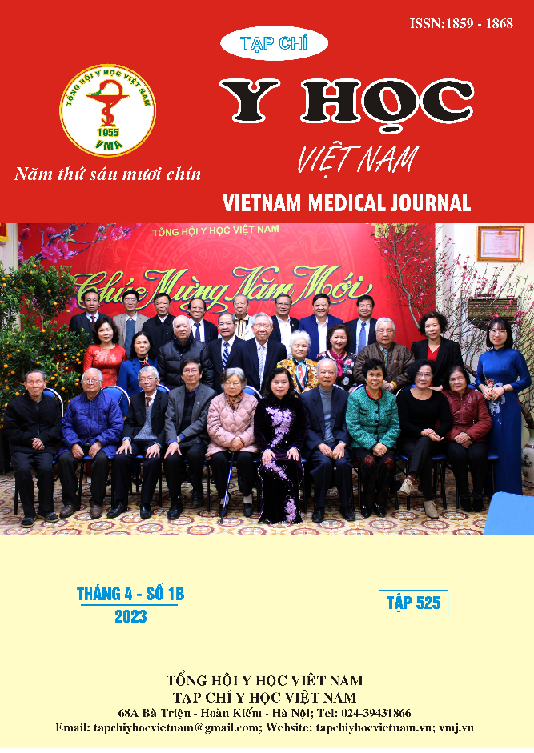ANTIBIOTIC RESISTANCE PATTERNS OF COMMON BACTERIAL STRAINS AT NGUYEN TRI PHUONG HOSPITAL FROM 2019 TO 2021
Main Article Content
Abstract
Objective: Describe the prevalence and the susceptibility patterns of common bacterial isolated from patients at the Intensive care unit in Nguyen Tri Phuong Hospital to several antimicrobials from 2019 to 2021. Materials and methods: Data on antimicrobial susceptibility were collected retrospectively from the Hospital Laboratory between January 2019 and December 2021. Results: Over the years 2019 - 2021, there were 6189 samples cultured at the Intensive care unit (ICU). After three years, there were no vancomycin-resistant Staphylococcus spp. strains with vancomycin MIC > 2 µg/mL and linezolid according to CLSI 2021. The rate of MRSA in the ICU is high. In which, the rate of MRSA with vancomycin MIC in the range of 1-2 µg/mL accounted for 15.8%. The susceptibility of E. coli was still sensitive over 50% to a few antibiotics and it was highly sensitive to carbapenems and aminoglycosides. K. pneumoniae had a susceptibility rate of less than 50% to all tested antibiotics. Acinetobacter spp. has a sensitivity of less than 20% to most of the tested antibiotics, only complete sensitivity to colistin, doxycycline (52.6%) and co-trimexazole (31.4%). P. aeruginosa has a sensitivity rate of less than 50% to quinolones, meropenem and 2.6% to co-trimexazole. Burkholderia spp. had a sensitivity of more than 50% to most antibiotics. Conclusion: The antibiotic susceptibility pattern in the Intensive care unit varied among the six commonly bacteria strains, but overall, the sensitivity tended to decrease. In which, Acinetobacter spp. has the lowest antibiotic sensitivity rate.
Article Details
Keywords
antimicrobials, Gram-positive, Gram-negative, susceptibility
References
2. Bùi Quang Hiền, Võ Thị Hà, Phạm Hồng Thắm. Khảo sát tình hình sử dụng kháng sinh trong điều trị viêm phổi bệnh viện do Pseudomonas aeruginosa tại Bệnh viện Nhân dân Gia Định. Tạp chí Y học TP. Hồ Chí Minh, 2020. 24(3): p. p100.
3. Bộ Y Tế. Báo cáo sử dụng kháng sinh và kháng kháng sinh tại 15 bệnh viện Việt Nam năm 2008-2009. Báo cáo của Bộ Y tế-Việt Nam phối hợp với Dự án Hợp tác toàn cầu về kháng kháng sinh GARPViệt Nam và Đơn vị Nghiên cứu Lâm sàng Đại học Oxford. 2009 :p14-15.
4. Hsu LY, Apisarnthanarak A, Khan E, Suwantarat N, Ghafur A, Tambyah PA. Carbapenem-Resistant Acinetobacter baumannii and Enterobacteriaceae in South and Southeast Asia. Clin Microbiol Rev, 2017, 30(1): p. 1-22.
5. Meena S., Bir, R., Sood, S., Das, B. K., & Kapil, A. Emergence of Burkholderia cepacia in ICU Setting. Indian journal of critical care medicine: peer-reviewed, official publication of Indian Society of Critical Care Medicine, 2019, 23(9), 423–426.
6. Kollef MH, Fraser VJ. Antibiotic resistance in the intensive care unit. Ann Intern Med, 2001, 134(4): p. 298-314.
7. Shariati, A., Dadashi, M., Moghadam, M.T. et al. Global prevalence and distribution of vancomycin resistant, vancomycin intermediate and heterogeneously vancomycin intermediate Staphylococcus aureus clinical isolates: a systematic review and meta-analysis. Scientific Reports, 2020, 10(1): p. 12689.
8. Walraven CJ, North MS, Marr-Lyon L, Deming P, Sakoulas G, Mercier RC. Site of infection rather than vancomycin MIC predicts vancomycin treatment failure in methicillin-resistant Staphylococcus aureus bacteraemia. J Antimicrob Chemother, 2011, 66(10): p. 2386-92.


